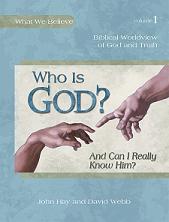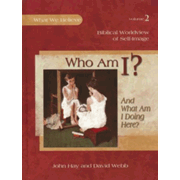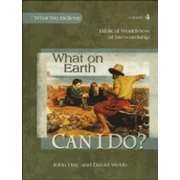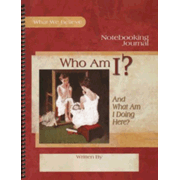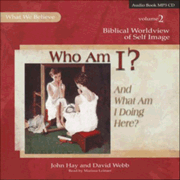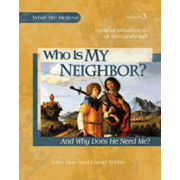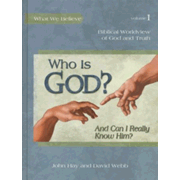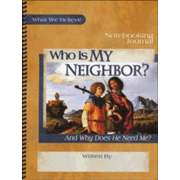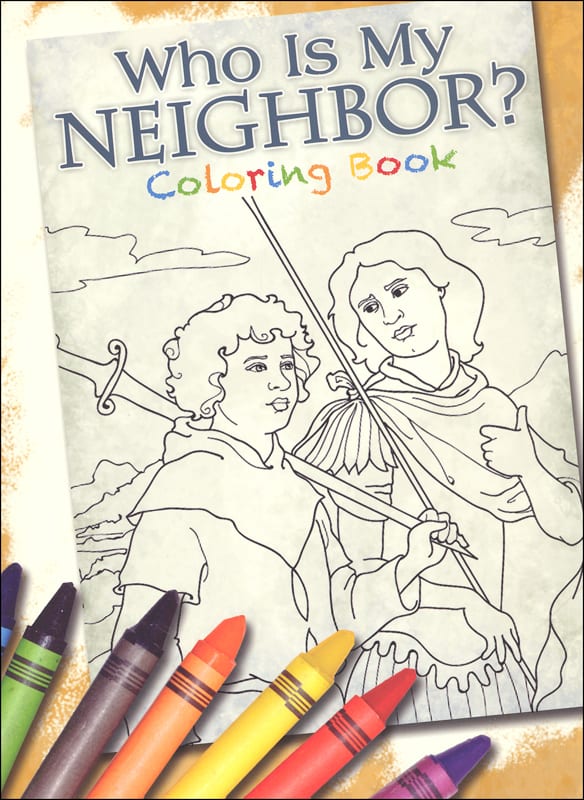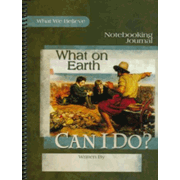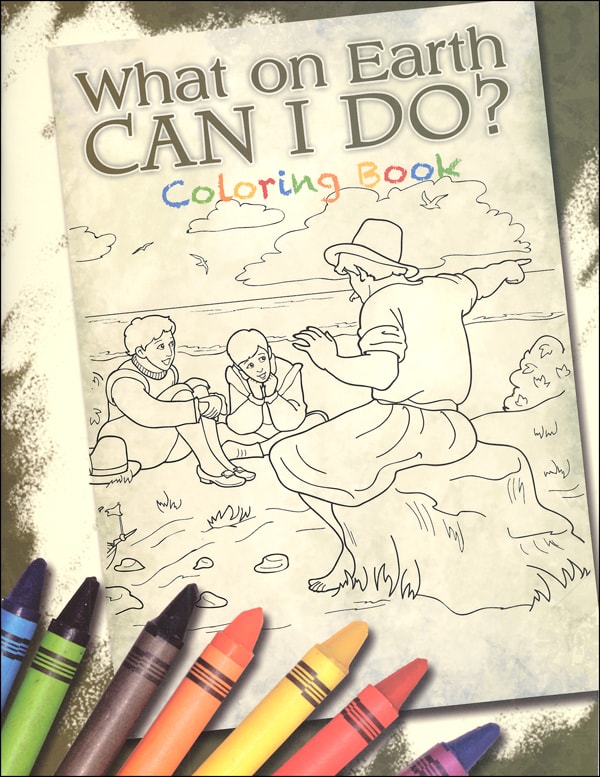The What We Believe series of four books helps children in the elementary grades construct a biblical Christian worldview from a Protestant perspective.
Who is God?, Who Am I?, Who Is My Neighbor?, and What on Earth Can I Do? are the titles of the four books. These beautiful, hardcover books feature plenty of full-color illustrations. Children will want to see the pictures even if you use the books as read-alouds. The combination of stories, activities, and discussion makes what could be heady content more accessible and interesting to younger children.
The authors suggest using the books with children ages six through fourteen, although I think children beyond age twelve might find parts too young, and younger children might find some of the vocabulary and concepts difficult to grasp. Nevertheless, I recommend trying to use these with the entire family, adapting as necessary to your children’s ages.
Four optional items are available as companions for each volume: a Notebooking Journal, a coloring book, a Junior Notebooking Journal, and a full audio version of the book.
The Notebooking Journals do not duplicate material in the core books. Instead, they offer note-taking pages, thought-provoking questions with space for students to write lengthy responses, puzzles, drawing activities, vocabulary words with space to write definitions, and a few other activities. The journals are great tools for engaging older students, especially those in junior high. They might work independently in their journals while you have a discussion with younger children on concepts already familiar to your junior high student.
Younger children might enjoy using the coloring books as you read aloud since the coloring pages correlate with the lessons. Junior Notebooking Journals are for ages six through nine. The Junior Notebooking Journals incorporate about one-third of the pages from the coloring books plus simple crossword and word search puzzles, some fill-in-the-blank questions, scripture verses to write and memorize, suggestions for songs and books, and suggestions for hands-on activities. The Junior Notebooking Journals fill the gap between the coloring book and the journals for older students.
While it's best for family members to read aloud from the books then discuss the material, sometimes the audio versions of the books might be used for the first reading or for review. Children might even want to re-listen to some of the stories.
Each lesson in the textbooks has a number of components. First, an introduction briefly reviews previous topics then presents the "big idea" of the upcoming lesson. Following that is a list of lesson objectives.
Many of the lessons feature fictional stories about children representing various worldviews. The stories are especially helpful for making the abstract worldview ideas more concrete for younger learners. Discussion questions following the stories help children grasp the ideas as well as implications for their own lives.
Children who can write might want to keep a notebook as they cover the lessons. Older students might maintain both a notebook and the Notebooking Journal. They should also write each lesson’s vocabulary words and definitions in their notebook.
While older students might complete more work independently, I think the layout of the lessons lends itself best to family read-aloud and discussion for at least part of each lesson. The entire family can work together on the two Bible verses to memorize for each lesson.
About twice per lesson, a box titled Make a Note of It provides a list of student questions, an extended Scripture reading with a reflection question, or something similar. These are not simple comprehension questions; they are thought-provoking questions to which older students should write responses in their notebooks. The questions are probably too challenging for children in the primary grades, so for them you should either simplify the questions or use them for discussion rather than for written assignments.
Lessons also include brief articles that integrate other topics such as the arts, science, and history. For example, an article on the eruption of Mount St. Helens helps children make sense of natural disasters in the context of a fallen world.
Some lessons include hands-on activities such as creating a Mobius strip or making s'mores clusters to eat. Some of these relate directly to lesson concepts, while others seem only marginally connected.
"What Should I Do?" sections teach godly character traits. Children learn appropriate responses, given what they have just learned about God and their relationship to Him. Prayers conclude the main part of each lesson.
Two final sections in the first volume develop deeper level worldview concepts and should help older children begin to develop some understanding and skill with apologetics. The final section in the first volume and selected lessons in the other volumes show a worldview model constructed like a building that has been adapted from Summit Ministries' Building on the Rock curriculum. (The What We Believe series was created in partnership with Summit Ministries.) The model construction begins with the first book and is completed as you work through the other three books.
The first book, Who Is God?: And Can I Really Know Him? introduces foundational ideas about the existence of God, our ability to recognize truth, the nature of God, the Trinity, God as creator, the Fall, the purpose of our existence, our relationship to God, the problem of sin and separation from God, and the necessity of Jesus for salvation.
The second book, Who Am I?: And What Am I Doing Here? helps children understand what it means to be made in the image and likeness of God. They consider what this means in regard to decision making and the use of their personal gifts and talents. Along with stories of children from other cultures and religious beliefs, this volume features a series of stories about Brandon, a young page who will eventually become a knight. It draws parallels between service to earthly kings and the King of Kings. A Worldviews in Focus story at the end of each lesson uses modern-day stories to introduce competing worldviews as they play out in the lives of people from around the world.
The third book, Who Is My Neighbor?: And Why Does He Need Me? helps children grasp the concept of servanthood. It teaches primarily through stories of Christian service in both ordinary life and extraordinary situations. It challenges children to consider what they ought to do on all levels—from within their families out to the broader world stage. "Encounters with Jesus" at the end of each lesson build on biblical stories of people who interacted with Jesus, fleshing out characters and creating a fuller backstory than we find in Scripture. These stories are then compared to the actual stories in the Bible and followed by questions that help tie together the stories with concepts of servanthood.
The fourth volume, What on Earth Can I Do?, teaches a biblical view of stewardship—the handling of our possessions, time, and talents, as well as our care for the environment and the health of our own bodies. At the end of each lesson, "Parables of Jesus" stories are expanded versions of Bible stories that illustrate stewardship. Questions at the end of each "parable" help students grasp what Jesus has to say about stewardship. The fourth book actually seems like much of it is targeted for an older audience. I would recommend it for children no younger than fourth-grade level since it deals with war, the evacuation of children from London in WWII, and other difficult subjects. Stewardship topics throughout the book also sometimes assume a familiarity with life issues such as work and finances, a familiarity that most young children do not have. While the Junior Notebooking Journal for this text provides age-appropriate activities for younger students, some of the stories and content of the main book still make the entire course more appropriate for older students.
The six-page introduction in each book explains how to use the series, although it does not fully describe the extensive teaching material available on the website. Apologia provides free, password-protected teaching resources on their website. While the teaching material is helpful, it is possible to work directly from the books without using the online teaching material at all. However, the online teaching material is especially useful if you have younger children since it provides discussion questions appropriate for them.
The ideas presented in the What We Believe series are actually quite challenging even though they are presented in a way that younger students can begin to think about them. While younger children might still find some ideas too abstract, they are likely to stay tuned in for the stories about children and some of the activities, and they are likely to pick up at least some of the concepts.
The What We Believe series should work very well for homeschooling families. It combines the convenience of using one resource for most or all of the family with a great introduction to worldviews in a format that children are likely to enjoy.
You might want to check out the ready-made lesson plans from Homeschool Planet that are available for What We Believe courses.
Find lesson plans available for this product at Homeschool Planet. Sign up for a 30-day FREE trial.





